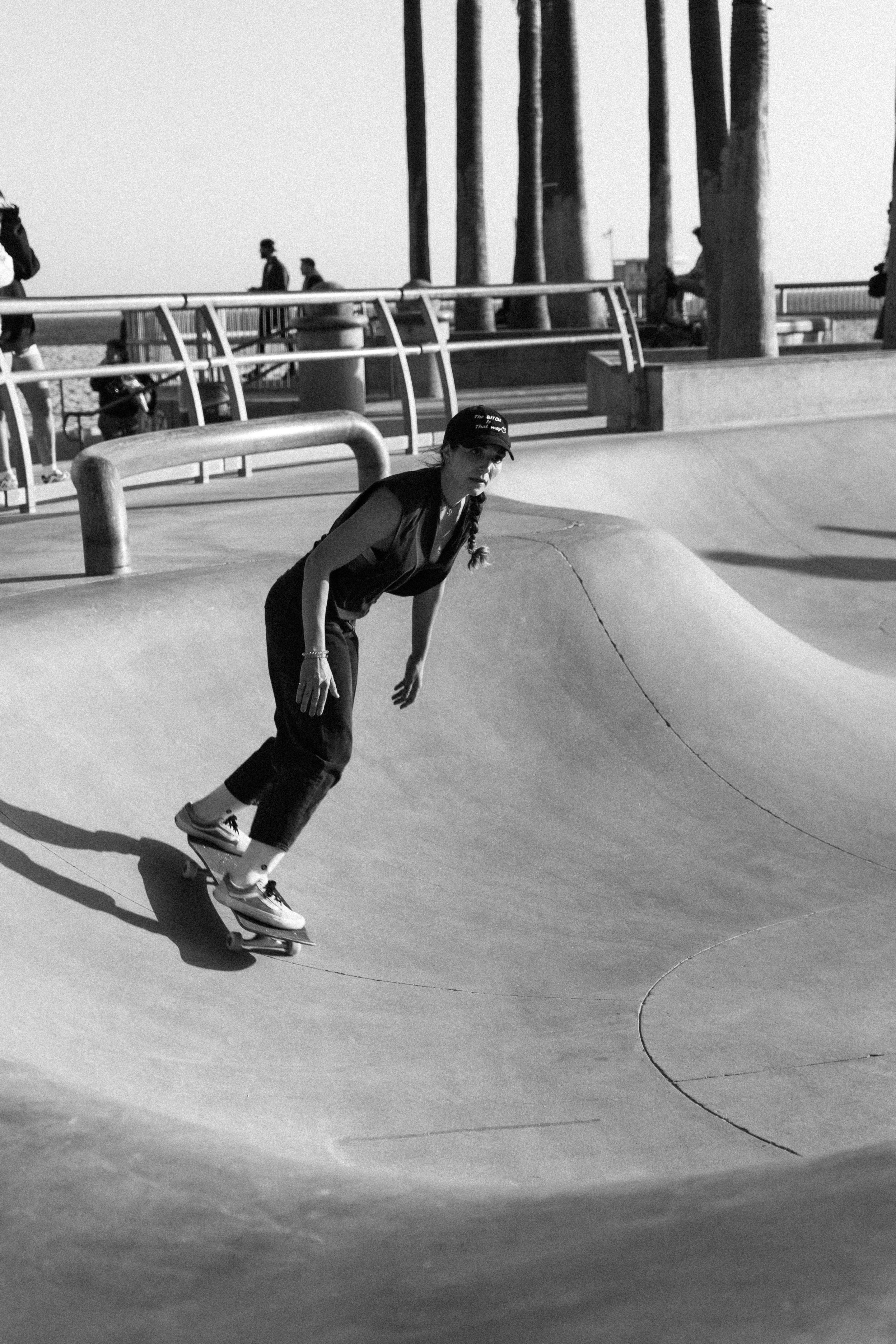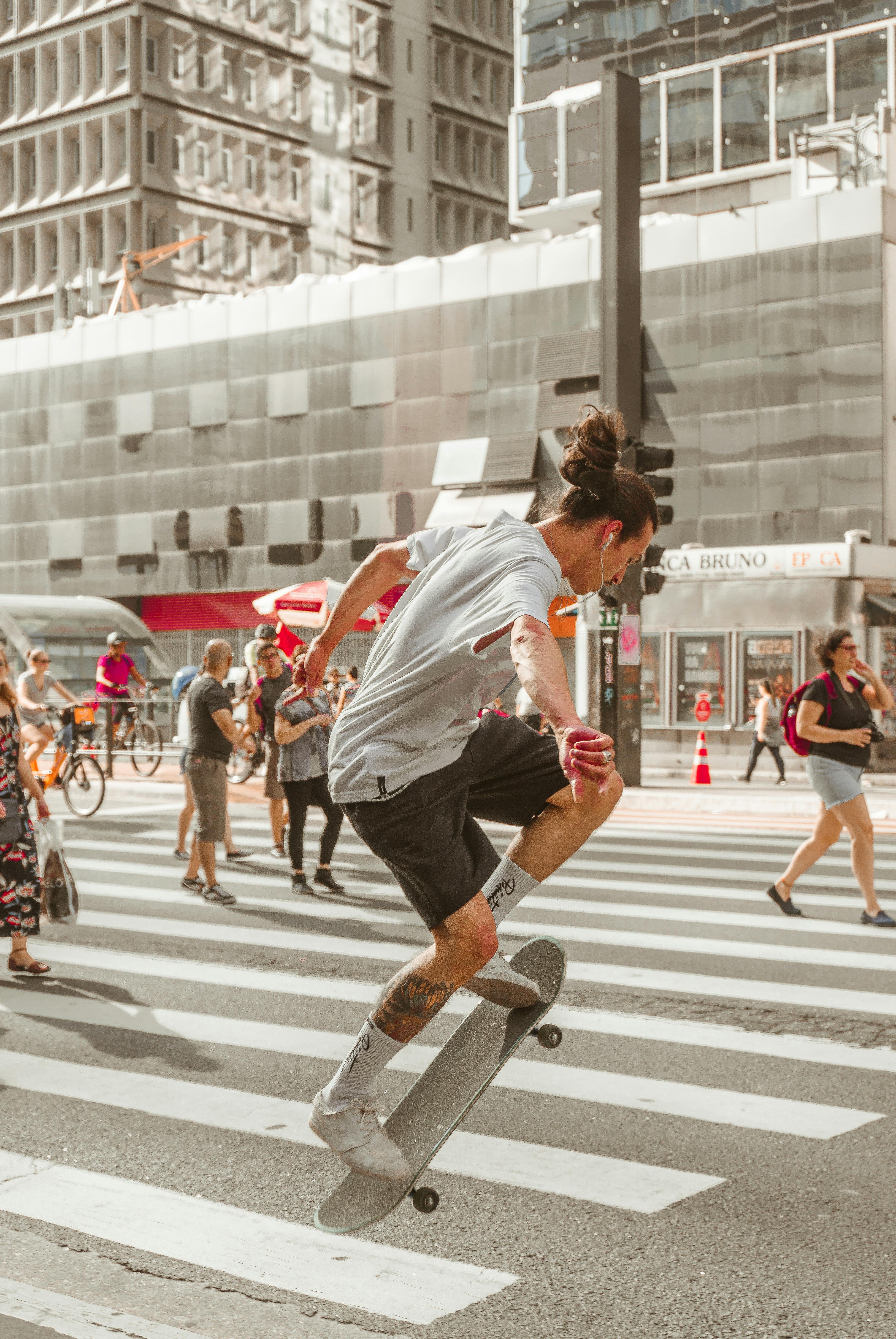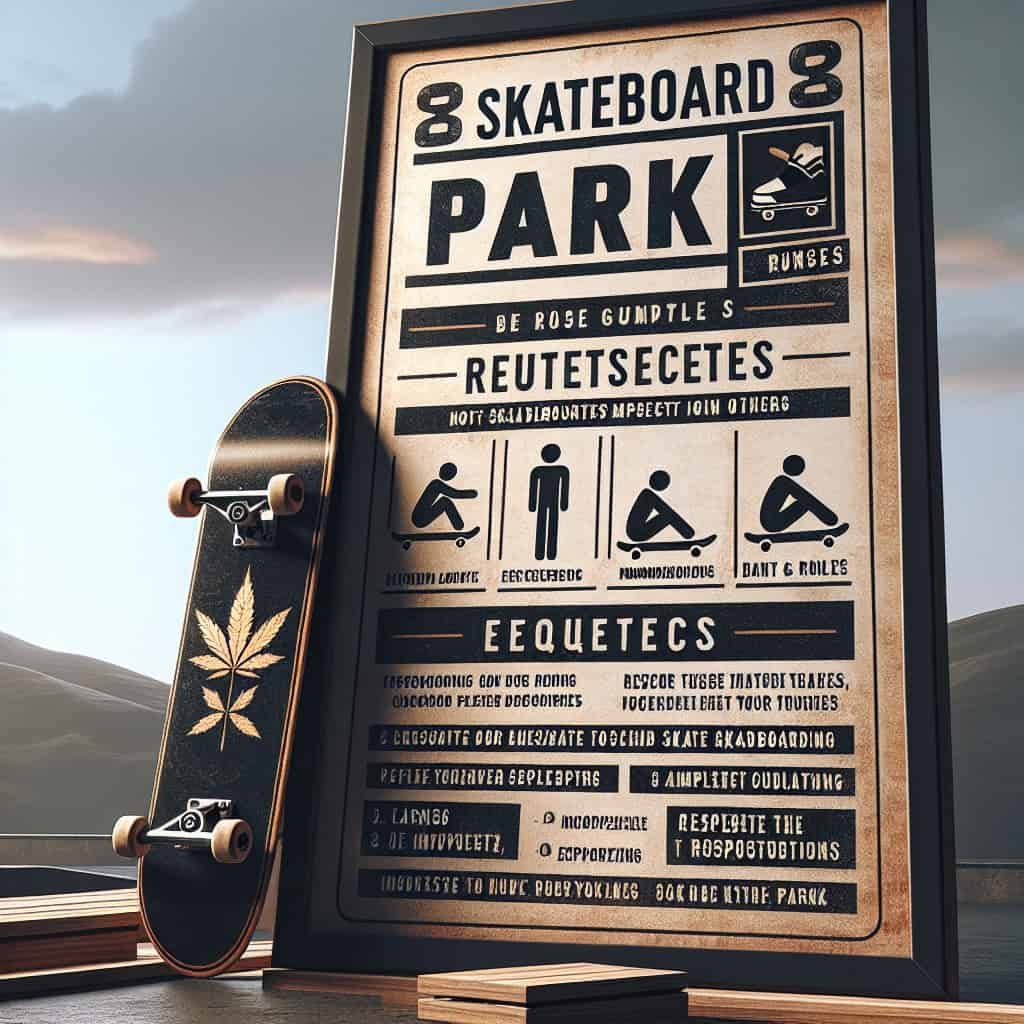Skateboarding etiquette and park rules play a crucial role in enhancing your learning and improvement journey on a skateboard. Understanding and abiding by these guidelines not only fosters a positive and inclusive skateboarding community, but also promotes safety and respect among fellow skaters. By adhering to proper etiquette and park rules, you create a conducive environment for practicing tricks, sharing the space with others, and ultimately advancing your skills. So let’s take a closer look at how skateboarding etiquette and park rules can contribute to your growth as a skateboarder.

Understanding Skateboarding Etiquette
Definition of skateboarding etiquette
Skateboarding etiquette refers to a set of unwritten rules and guidelines that govern the behavior and conduct of skateboarders in the skateboarding community. It outlines the proper way to interact with fellow skaters, utilize skateboarding facilities, and promote a positive and respectful environment for all participants.
Importance of skateboarding etiquette in the skateboarding community
Skateboarding etiquette plays a crucial role in maintaining a harmonious and inclusive skateboarding community. By adhering to these guidelines, skaters can create a supportive and enjoyable atmosphere where everyone feels welcome and respected. It helps prevent conflicts, accidents, and misunderstandings, ensuring that skateboarding remains a safe and enjoyable activity for all.
Adherence to skateboarding etiquette as a sign of respect
Following skateboarding etiquette demonstrates respect for not only the fellow skaters but also the skateboarding culture as a whole. It shows a commitment to the community and an understanding of the values and principles that underpin skateboarding. By adhering to the accepted norms and practices, skaters can establish positive relationships, build trust, and foster a sense of camaraderie within the skateboarding community.
The role of skateboarding etiquette in fostering a positive skateboarding culture
Skateboarding etiquette plays a vital role in cultivating a positive skateboarding culture. By promoting values such as respect, inclusivity, and cooperation, it lays the foundation for a supportive and vibrant community. Such a culture encourages skaters to share knowledge, offer guidance, and inspire each other to push their limits and improve their skills. Furthermore, a positive skateboarding culture enhances the overall reputation of the skateboarding community, breaking down stereotypes and misconceptions.
The Significance of Park Rules
Explanation of park rules at skateboarding parks
Park rules are guidelines and regulations implemented by skateboarding parks to ensure the safety and well-being of all skaters. These rules typically cover a wide range of aspects, including appropriate behavior, facility usage, and compliance with local laws. Park rules are usually prominently displayed at the entrance or throughout the park to provide easy access to skaters.
Establishment of park rules for safety purposes
One of the primary reasons for implementing park rules is to prioritize the safety of skateboarders. These rules lay out the expectations and standards for behavior, ensuring that all skaters understand and follow the necessary precautions. By establishing guidelines such as wearing proper protective gear, utilizing designated areas for tricks, and respecting speed limits, parks aim to minimize the risk of accidents and injuries.
Ensuring fair and equal access to skateboarding facilities
Park rules also serve the purpose of ensuring fair and equal access to skateboarding facilities for all skateboarders. By setting guidelines on factors such as maximum occupancy, session duration, and sharing of space, parks strive to create an environment where everyone has the opportunity to enjoy the facilities without feeling overcrowded or restricted.
Compliance with park rules as a fundamental aspect of responsible skateboarding
Compliance with park rules is not only a legal obligation but also a fundamental aspect of responsible skateboarding. By adhering to these rules, skateboarders demonstrate accountability and consideration for their own well-being and the well-being of others. Moreover, responsible skateboarding helps maintain a positive relationship between the skateboarding community and the local authorities, thus preserving and improving skateboarding opportunities in the long run.
Safety Measures and Protocols
Wearing proper protective gear
Safety should always be a top priority in skateboarding, and wearing proper protective gear is a crucial aspect of ensuring personal safety. Skaters should always wear a helmet, knee pads, elbow pads, and wrist guards to protect themselves from potential injuries during falls or accidents. By prioritizing their own safety, skaters set a positive example for others and create a safe environment for everyone to enjoy.
Executing tricks in designated areas
To minimize the risk of collisions and accidents, skateboarders should execute tricks and maneuvers only in designated areas or on equipment specifically designed for such purposes. This helps ensure that other skaters can anticipate movements and navigate around the park safely. By respecting these designated areas, skaters show consideration for their fellow skateboarders and help maintain a safe and organized skateboarding environment.
Obeying speed limits and yielding to others
Maintaining a controlled speed and yielding to others when necessary is essential to prevent accidents and maintain a safe skateboarding environment. Skateboarders should follow any posted speed limits or guidelines within the park and always give the right of way to pedestrians, cyclists, or other skaters. Being aware of one’s surroundings and practicing caution goes a long way in preventing collisions and promoting a safe skateboarding experience for all.
Avoiding reckless behavior and dangerous stunts
Reckless behavior and dangerous stunts not only endanger the safety of the skater but also pose a risk to others in the park. Skateboarders should refrain from attempting tricks or maneuvers that are beyond their skill level or that may put themselves or others at risk. By exercising judgment and avoiding reckless behavior, skateboarders contribute to a safe and enjoyable skateboarding environment.
Respecting Fellow Skaters
Giving way to other skaters
Respecting the flow and rhythm of the skate park is essential for maintaining a harmonious environment. Skaters should be mindful of others and yield to those who are already utilizing a particular area or performing a trick. Giving way to fellow skaters not only promotes safety but also encourages a cooperative and considerate atmosphere where everyone has an equal opportunity to enjoy the facilities.
Communicating and signaling intentions
Clear communication and proper signaling of intentions are instrumental in avoiding accidents and misunderstandings. Skateboarders should use verbal cues, hand signals, or eye contact to communicate their intentions to others nearby. Whether it’s indicating a change in direction or signaling a trick attempt, effective communication helps create a safer and more cohesive skateboarding experience for everyone involved.
Avoiding hogging or monopolizing space
Skateboarding parks are communal spaces meant to be shared by all. Skaters should avoid hogging or monopolizing space for extended periods, especially in high-traffic or popular areas of the park. Being aware of one’s presence and ensuring that others have a fair chance to utilize the facilities fosters a sense of inclusivity and respect within the skateboarding community.
Assisting and encouraging fellow skaters
The spirit of camaraderie is a significant aspect of skateboarding culture. Skaters should strive to assist and encourage their fellow skateboarders, particularly those who are less experienced or attempting new tricks. Offering helpful suggestions, cheering each other on, and providing a supportive environment can contribute to personal growth, skill development, and an overall positive skateboarding experience.

Managing Crowded Environments
Navigating crowded skate parks effectively
Skate parks can get crowded, especially during peak hours or on weekends. In such scenarios, it is essential to navigate the park effectively to prevent accidents and maintain a smooth flow of movement. Skaters can do this by being aware of the surroundings, taking extra caution when passing others, and identifying open areas to practice or congregate, thus minimizing the risk of collisions or congestion.
Taking turns and practicing patience
In crowded environments, it becomes crucial to establish a system of taking turns to ensure everyone’s fair access to the facilities. Skateboarders should practice patience and wait for their turn rather than attempting to cut in line or disrupt the flow. This courteous behavior helps maintain a harmonious atmosphere and prevents unnecessary conflicts or frustrations.
Prioritizing safety in high-traffic areas
High-traffic areas within the skate park, such as ramps or railings, require heightened attention and a focus on safety. Skateboarders should prioritize safety by avoiding unnecessary congestion, practicing extra caution, and being mindful of fellow skaters’ movements. By doing so, skaters contribute to a safer environment for everyone and minimize the risk of collisions or accidents.
Respecting the park’s guidelines on maximum occupancy
Skate parks often have guidelines regarding the maximum occupancy or limit on the number of skaters allowed at a given time. Respecting these guidelines is essential to prevent overcrowding, ensure everyone’s safety, and maintain a balanced usage of the facilities. Skateboarders should be aware of any occupancy limits and cooperate by adjusting their visit accordingly or returning at less crowded times.
Elevating Skill Levels through Cooperation
Sharing tips and techniques among skaters
Skateboarding is a sport that thrives on shared knowledge and continuous learning. Skaters can elevate their skill levels by actively engaging with their peers and sharing tips, techniques, and experiences. Whether it’s discussing proper foot placement, suggesting adjustments to improve balance, or demonstrating a new trick, the exchange of knowledge enhances skill development and fosters a collaborative skateboarding community.
Providing constructive feedback and advice
Offering constructive feedback and advice is an integral part of the skateboarding community’s growth and improvement. Skaters should be open to receiving feedback from others and provide constructive criticism when appropriate. By fostering a supportive environment where skaters can learn from each other and exchange valuable insights, the community as a whole can continually evolve and push the boundaries of skateboarding.
Learning from more experienced skateboarders
Skate parks often attract skateboarders of varying experience levels. Skaters, particularly those who are less experienced, can learn a great deal by observing and interacting with more experienced skateboarders. Whether it’s witnessing advanced techniques, seeking guidance, or receiving mentorship, learning from experienced skateboarders provides invaluable opportunities to expand skill sets and enhance overall performance.
Creating a supportive learning environment
Promoting a supportive learning environment is crucial for the growth and improvement of skateboarders, regardless of their skill level. Skaters should encourage each other’s progress, celebrate achievements, and offer a helping hand when needed. By fostering a positive and inclusive atmosphere, skateboarders create an environment where everyone feels comfortable pushing their limits, experimenting with new tricks, and taking their skills to the next level.

Promoting Inclusivity and Diversity
Welcoming skaters of all backgrounds
The skateboarding community should strive to be welcoming and inclusive, embracing skaters of all backgrounds, genders, ages, and skill levels. Creating an environment that celebrates diversity not only enriches the skateboarding experience but also dismantles barriers and challenges stereotypes. By actively promoting inclusivity, skateboarders can contribute to a more vibrant and progressive skateboarding culture.
Fostering a sense of belonging and acceptance
Skateboarders should actively foster a sense of belonging and acceptance within the community. By making an effort to engage with newcomers, offering encouragement and support, and ensuring everyone feels welcome and valued, skateboarders can create a nurturing environment where individuals can freely express their love for skateboarding without fear of judgment or exclusion.
Avoiding discriminatory language or behavior
Skateboarders should be mindful of their language and behavior to avoid any form of discrimination. Offensive slurs, derogatory remarks, or exclusivist attitudes have no place in skateboarding. By promoting respect and sensitivity towards all individuals, regardless of their background, skateboarders contribute to a more inclusive and welcoming skateboarding community.
Celebrating the diversity of the skateboarding community
The skateboarding community is a tapestry of diverse individuals with unique backgrounds and stories. Skateboarders should take pride in this diversity and actively celebrate it. This could involve promoting events or competitions that highlight different styles, cultures, or perspectives within skateboarding or encouraging the showcase of individual creativity and expression. Together, skateboarders can create a community that embraces and cherishes its rich diversity.
Maintaining Park Facilities
Respecting the park’s property and infrastructure
Respecting the park’s property and infrastructure is essential for the longevity and sustainability of the facilities. Skateboarders should refrain from damaging or vandalizing park property, such as ramps, rails, or benches. By treating the park with care and respect, skateboarders contribute to the well-being of the facilities and ensure their availability for future use.
Picking up trash and disposing of it properly
A clean and well-maintained skateboarding park enhances the overall experience for everyone. Skateboarders should take responsibility for the cleanliness of the park by picking up any trash or litter they may generate during their visit. Properly disposing of this waste or utilizing designated waste disposal containers helps preserve the park’s cleanliness and ensures a pleasant environment for all.
Reporting any damages or hazards
Skateboarders should promptly report any damages or hazards they observe in the park to the relevant authorities or park management. Identifying and addressing potential safety hazards, such as loose hardware, cracks in surfaces, or damaged equipment, is crucial to prevent accidents and maintain a safe environment. By being proactive and reporting issues promptly, skateboarders contribute to the overall well-being of the park and the safety of fellow skaters.
Volunteering for park maintenance initiatives
Skateboarders can actively contribute to the maintenance and improvement of park facilities by volunteering for park maintenance initiatives. These initiatives could involve activities such as painting, cleaning, or assisting with repairs under the guidance of the park management. By actively participating in such endeavors, skateboarders foster a sense of ownership and pride in the park, ensuring its continued viability and enhancement for everyone to enjoy.
Understanding Local Regulations
Gaining knowledge of local skateboarding laws
Understanding and abiding by local skateboarding laws is crucial for responsible skateboarding. Laws may vary from one jurisdiction to another, and it is essential for skateboarders to familiarize themselves with these regulations. This can include knowledge of any age restrictions, helmet requirements, or limitations on where skateboarding is permitted. By respecting these laws, skateboarders maintain a positive relationship with the local authorities and contribute to the sustainability of skateboarding opportunities within their community.
Respecting restrictions and curfews
Skateboarding parks or public areas may have specific restrictions or curfews in place to manage usage, noise levels, or the impact on surrounding residents. Respecting these restrictions and curfews is essential to maintain a positive relationship with the community and ensure the continued availability of skateboarding facilities. Skateboarders should be aware of and adhere to any posted guidelines to foster a harmonious coexistence with the surrounding environment.
Avoiding public areas not designated for skateboarding
Skateboarding should be limited to areas specifically designated and intended for skateboarding. Public areas such as sidewalks, parking lots, or privately-owned property should not be utilized for skateboarding unless explicitly permitted. Respecting this boundary helps prevent conflicts with pedestrians, motorists, and property owners, and preserves a positive image of skateboarding in the eyes of the wider public.
Engaging with local authorities to improve skateboarding opportunities
Skateboarders can play an active role in improving skateboarding opportunities within their community by engaging with local authorities. This could involve proposing new skateboarding facilities, advocating for the renovation or expansion of existing parks, or participating in public consultations on skateboarding-related matters. By actively engaging with local authorities, skateboarders can contribute to the development and enhancement of skateboarding opportunities for themselves and future generations.
Promoting Positive Image of Skateboarding
Positively representing the skateboarding community
Skateboarders hold the power to change public perception by positively representing the skateboarding community. This can be achieved by adhering to skateboarding etiquette, following park rules, and demonstrating responsible and respectful behavior both on and off the skateboard. By acting as ambassadors for the sport, skateboarders can help dispel negative stereotypes and misconceptions, fostering a more positive and inclusive image of skateboarding.
Engaging in community outreach and events
Participating in community outreach initiatives and events allows skateboarders to foster positive relationships with the broader community. By organizing skateboarding workshops, demonstrations, or competitions that are open to the public, skateboarders can engage with people of all ages and backgrounds, promoting the sport while showcasing the talent, creativity, and diversity within the skateboarding community. Building bridges with the wider community can open doors for cooperation, understanding, and support for skateboarding endeavors.
Educating others about skateboarding culture
Skateboarders can take an active role in educating others about the culture, history, and significance of skateboarding. This can involve sharing personal stories, organizing educational talks or workshops, or contributing to local publications or online platforms. By fostering a better understanding of skateboarding among the general public, skateboarders can challenge preconceived notions, break down barriers, and foster support for skateboarding within society.
Dispelling misconceptions and stereotypes
Skateboarders have the power to dispel misconceptions and stereotypes commonly associated with the sport. By showcasing the diversity, creativity, and skill within the skateboarding community, skateboarders challenge the notion that skateboarding is solely a rebellious or dangerous activity. Through positive interactions, open communication, and sharing personal experiences, skateboarders can actively address and refute stereotypes, promoting a more accurate and nuanced understanding of skateboarding.
In conclusion, skateboarding etiquette, park rules, and responsible behavior play a crucial role in nurturing a positive and inclusive skateboarding community. By prioritizing safety, respecting fellow skaters, managing crowded environments, promoting cooperation and diversity, maintaining park facilities, understanding local regulations, and actively promoting a positive image of skateboarding, skateboarders contribute to the growth, improvement, and sustainability of the sport. Through collective efforts and adherence to these principles, the skateboarding community can continue to flourish and inspire generations of skateboarders to come.

